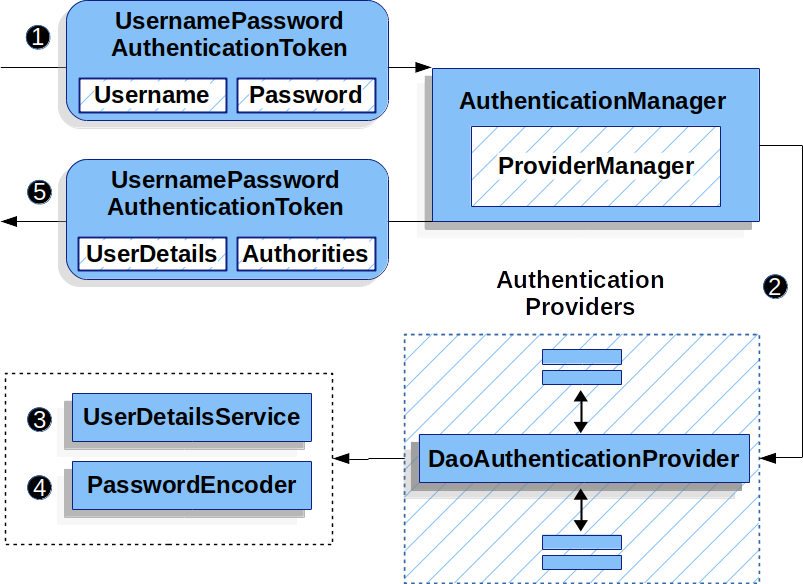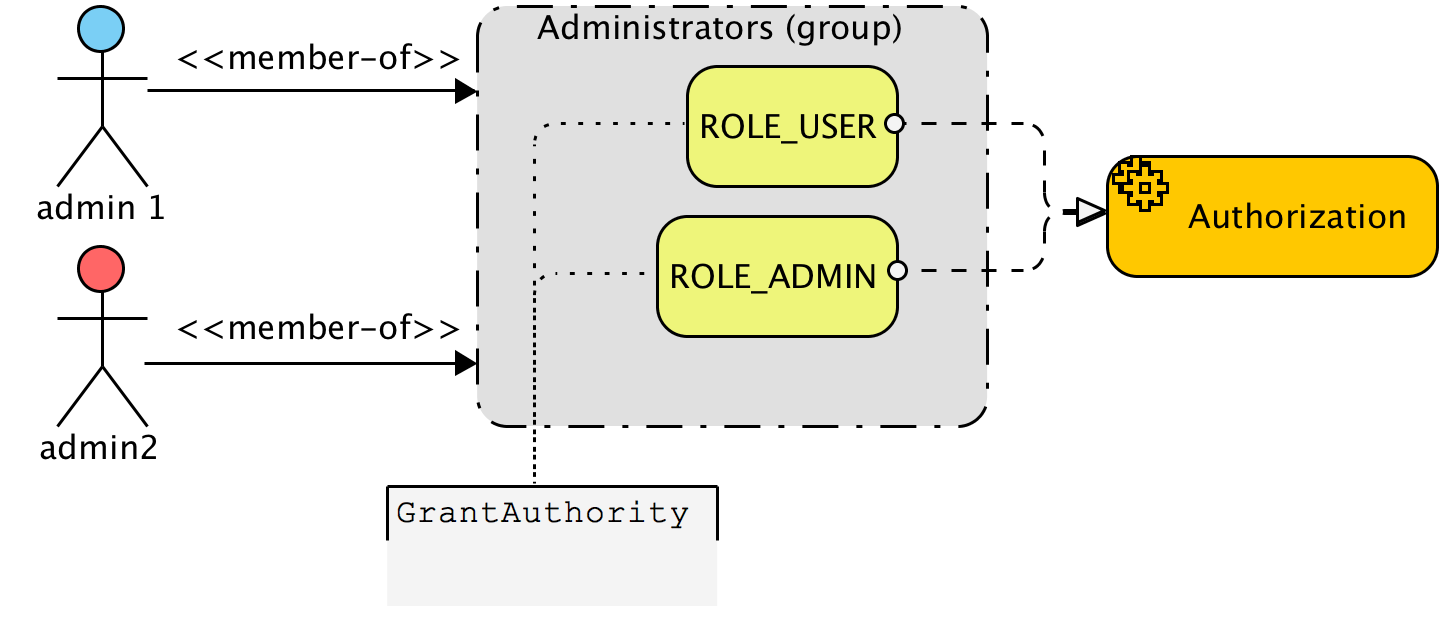依照前篇文章成功驗證後, 會生成授權
授權 authorization
UsernamePasswordAuthenticationToken
UsernamePasswordAuthenticationToken是Spring Security中代表用戶身份驗證請求的一種實現。實現Authentication接口,用於封裝用戶名和密碼的身份驗證資訊。

1. 身份驗證前
包含用戶名和 密碼,用於提交到AuthenticationManager進行身份驗證
1
| UsernamePasswordAuthenticationToken(Object principal, Object credentials)
|
principal 通常是用戶名或帳號credentials 為密碼
2. 身份驗證後
在認證通過後會renew 一個Object
1
| UsernamePasswordAuthenticationToken(Object principal, Object credentials, Collection<? extends GrantedAuthority> authorities)
|
principal: 這時代表已驗證的用戶,通常是一個UserDetails對象,包含了用戶的詳細資訊。credentials:出於安全考慮,一旦用戶通過身份驗證,該資訊通常會被清空或設為null,因為後續不再需要密碼。authorities:一個GrantedAuthority對象的集合,代表了該用戶擁有的權限。這允許Spring Security對用戶進行細粒度的訪問控制。
驗證後的細微度劃分
UserDetails和Authorities是實現細粒度安全控制的兩個關鍵概念。它們共同作用於身份驗證和授權過程,確保只有具有適當權限的用戶能夠訪問特定資源。以下是對這兩個概念的詳細解釋:
UserDetail
接口,其中包括用戶名、密碼、賬戶狀態(如是否啟用、賬戶是否過期等)以及用戶的權限
UserDetails接口的主要方法包括:
- getUsername(): 獲取用戶的用戶名。
- getPassword(): 獲取用戶的密碼。
- isEnabled(): 判斷用戶是否啟用。
- isAccountNonExpired(): 判斷賬戶是否未過期。
- isCredentialsNonExpired(): 判斷憑證(密碼)是否未過期。
- isAccountNonLocked(): 判斷賬戶是否未鎖定。
- getAuthorities(): 獲取用戶的權限集合。
Authorities
代表用戶的權限或角色, 透過 GrantedAuthority 封裝授權字串
後續可以通過基於基於角色的訪問控制(如hasRole(‘ROLE_ADMIN’))和基於表達式的訪問控制(如hasAuthority(‘READ_PRIVILEGE’))來實現細粒度的安全策略。

範例
自定義UserDetail
1
2
3
4
5
6
7
8
9
10
11
12
13
14
15
16
17
18
19
20
21
22
23
24
25
26
27
28
29
30
31
32
33
34
35
| import org.springframework.security.core.userdetails.UserDetails;
import org.springframework.security.core.authority.SimpleGrantedAuthority;
import org.springframework.security.core.GrantedAuthority;
import java.util.Collection;
import java.util.stream.Collectors;
public class CustomUserDetails implements UserDetails {
private User user;
public CustomUserDetails(User user) {
this.user = user;
}
@Override
public Collection<? extends GrantedAuthority> getAuthorities() {
return user.getRoles().stream()
.flatMap(role -> role.getPermissions().stream())
.map(permission -> new SimpleGrantedAuthority(permission.getName()))
.collect(Collectors.toList());
}
@Override
public String getPassword() {
return user.getPassword();
}
@Override
public String getUsername() {
return user.getUsername();
}
}
|
自定義UserDetailsService
1
2
3
4
5
6
7
8
9
10
11
12
13
14
15
16
| import org.springframework.security.core.userdetails.UserDetailsService;
import org.springframework.security.core.userdetails.UsernameNotFoundException;
public class CustomUserDetailsService implements UserDetailsService {
@Override
public UserDetails loadUserByUsername(String username) throws UsernameNotFoundException {
User user = userRepository.findByUsername(username);
if (user == null) {
throw new UsernameNotFoundException("User not found");
}
return new CustomUserDetails(user);
}
}
|
使用@PreAuhorize
1
2
3
4
5
6
7
8
9
10
11
12
13
14
15
16
17
18
| import org.springframework.security.access.prepost.PreAuthorize;
@RestController
public class TestController {
@PreAuthorize("hasAuthority('READ_PRIVILEGE')")
@GetMapping("/read")
public String read() {
return "Reading content...";
}
@PreAuthorize("hasAuthority('WRITE_PRIVILEGE')")
@PostMapping("/write")
public String write() {
return "Writing content...";
}
}
|

